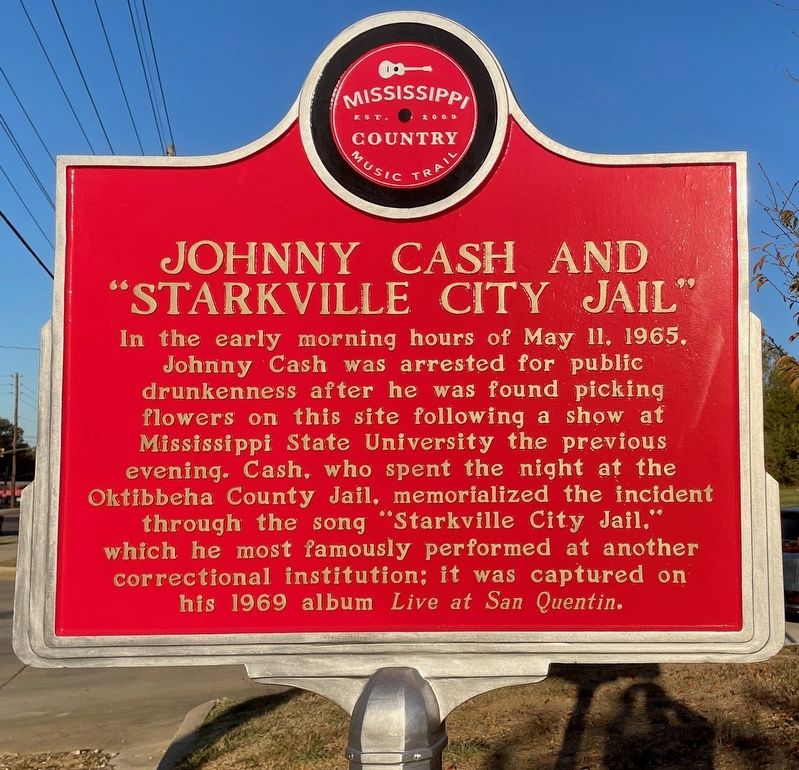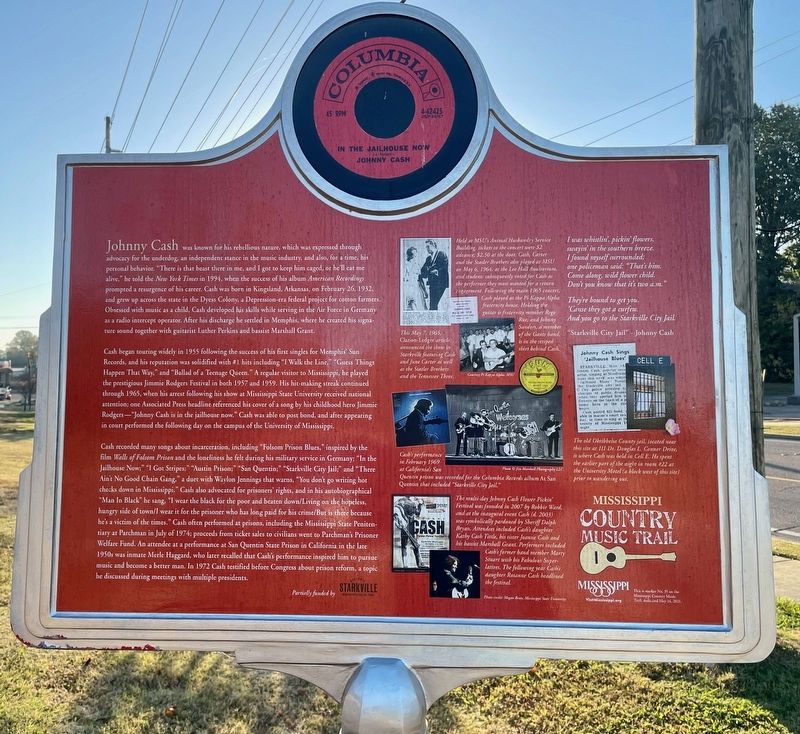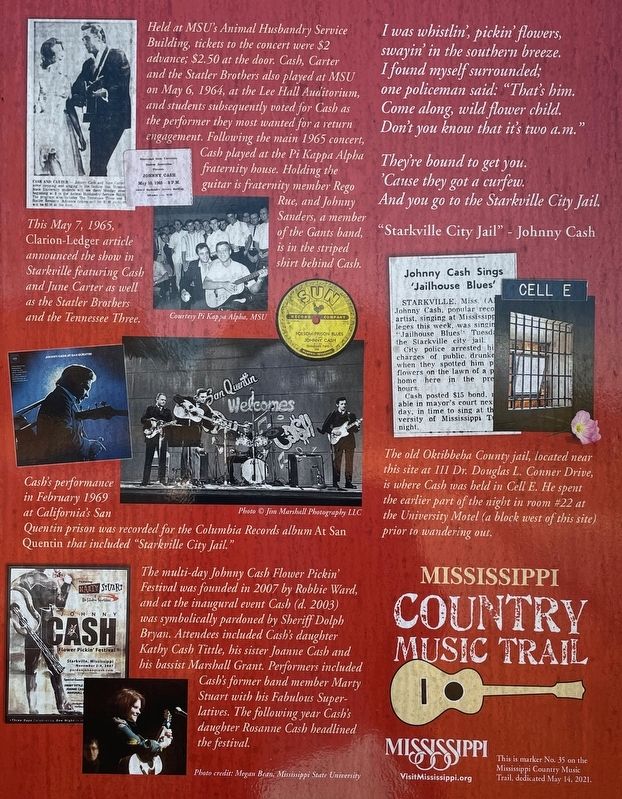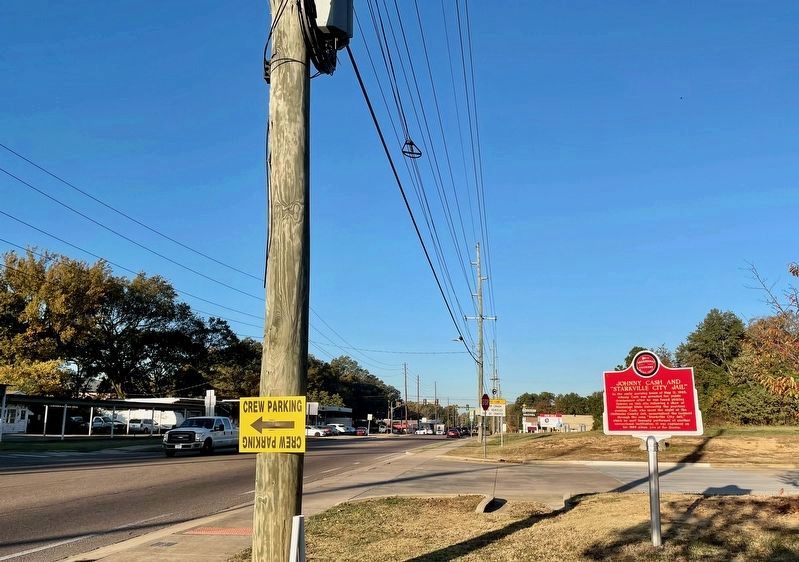Starkville in Oktibbeha County, Mississippi — The American South (East South Central)
Johnny Cash and “Starkville City Jail”
— Mississippi Country Music Trail —
Johnny Cash was known for his rebellious nature, which was expressed through advocacy for the underdog, an independent stance in the music industry, and also, for a time, his personal behavior. “There is that beast there in me, and I got to keep him caged, or he’ll eat me alive,” he told the New York Times in 1994, when the success of his album American Recordings prompted a resurgence of his career. Cash was born in Kingsland, Arkansas, on February 26, 1932, and grew up across the state in the Dyess Colony, a Depression-era federal project for cotton farmers. Obsessed with music as a child, Cash developed his skills while serving in the Air Force in Germany as a radio intercept operator. After his discharge he settled in Memphis, where he created his signature sound together with guitarist Luther Perkins and bassist Marshall Grant.
Cash began touring widely in 1955 following the success of his first singles for Memphis’ Sun Records, and his reputation was solidified with #1 hits including “I Walk the Line,” “Guess Things Happen That Way,” and “Ballad of a Teenage Queen.” A regular visitor to Mississippi, he played the prestigious Jimmie Rodgers Festival in both 1957 and 1959. His hit-making streak continued through 1965, when his arrest following his show at Mississippi State University received national attention; one Associated Press headline referenced his cover of a song by his childhood hero Jimmie Rodgers—“Johnny Cash is in the jailhouse now.” Cash was able to post bond, and after appearing in court performed the following day on the campus of the University of Mississippi.
Cash recorded many songs about incarceration, including “Folsom Prison Blues,” inspired by the film Walls of Folsom Prison and the loneliness he felt during his military service in Germany; “In the Jailhouse Now;” “I Got Stripes;” “Austin Prison;” “San Quentin;” “Starkville City Jail;” and “There Ain’t No Good Chain Gang,” a duet with Waylon Jennings that warns, “You don’t go writing hot checks down in Mississippi.” Cash also advocated for prisoners’ rights, and in his autobiographical “Man In Black” he sang, “I wear the black for the poor and beaten down/Living on the hopeless, hungry side of town/I wear it for the
prisoner who has long paid for his crime/But is there because he’s a victim of the times.” Cash often performed at prisons, including the Mississippi State Penitentiary at Parchman in July of 1974; proceeds from ticket sales to civilians went to Parchman’s Prisoner Welfare Fund. An attendee at a performance at San Quentin State Prison in California in the late 1950s was inmate Merle Haggard, who later recalled that Cash’s performance inspired him to pursue music and become a better man. In 1972 Cash testified before Congress about prison reform, a topic he discussed during meetings with multiple presidents.
Erected 2021 by the Mississippi Country Music Trail. (Marker Number 35.)
Topics and series. This historical marker is listed in these topic lists: Arts, Letters, Music • Entertainment. In addition, it is included in the Mississippi Country Music Trail series list. A significant historical date for this entry is February 26, 1932.
Location. 33° 27.964′ N, 88° 48.901′ W. Marker is in Starkville, Mississippi, in Oktibbeha County. Marker is at the intersection of Dr Martin Luther King Jr Dr E (Mississippi Route 182) and North Lafayette Street, on the right when traveling west on Dr Martin Luther King Jr Dr E. Touch for map. Marker is in this post office area: Starkville MS 39759, United States of America. Touch for directions.
Other nearby markers. At least 8 other markers are within walking distance of this marker
. Starkville (approx. 0.2 miles away); Significant Events in African-American History in Oktibbeha County (approx. 0.2 miles away); First Presbyterian Church (approx. 0.2 miles away); First Baptist Church (approx. ¼ mile away); Hic A Sha Ba Ha Spring (approx. 0.3 miles away); The Borden Milk Plant (approx. 0.4 miles away); Odd Fellows Cemetery (approx. 0.4 miles away); Oktibbeha Gardens (approx. 0.4 miles away). Touch for a list and map of all markers in Starkville.
Also see . . . Rolling Stone article - That Time Johnny Cash Was Arrested in Starkville, Mississippi. (Submitted on October 28, 2023, by Mark Hilton of Montgomery, Alabama.)
Credits. This page was last revised on October 28, 2023. It was originally submitted on October 28, 2023, by Mark Hilton of Montgomery, Alabama. This page has been viewed 104 times since then and 54 times this year. Photos: 1, 2, 3, 4. submitted on October 28, 2023, by Mark Hilton of Montgomery, Alabama.



